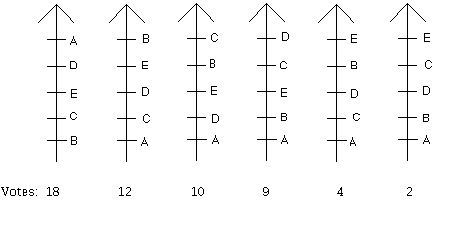
Problem Set 2: (Election Methods)
Prepared by:
Joseph Malkevitch
Department of Mathematics and Computer Studies
York College (CUNY)
Jamaica, New York
email:
malkevitch@york.cuny.edu
web page:
http://york.cuny.edu/~malk
1. The figure shows a sample preference or ordinal ballot where there are 5 candidates being ranked.

In this diagram B and C are preferred to A, D and E; A and D are viewed with indifference or tied, but A and D are each preferred to E.
a. Write down all possible different ordinal ballots which voters might produce that involve 3 candidates listed but where there are no ties between the candidates being ranked. (Use candidate names A, B, and C.)
b. How many different ordinal ballots would there be with n candidates where there are no ties between the candidates being ranked?.
c. Write down all possible different ordinal ballots which voters might produce that involve 3 candidates listed but where there can be ties between some or all of the candidates being ranked. (Use candidate names A, B, and C.)
2. Decide the winner (or state why there is none) of the elections shown below using:
a. Plurality, b. Ordinary run-off, c. Sequential run-off, d. Borda count, e. Condorcet's method, f. Baldwin's method, g. Nanson's method, h. Bucklin's method, i. Coombs, j. Minimax

3. Repeat the problem above but where the number of votes for each of the six types of ballots shown above has been reduced by one vote. Compare your results to what happens in Problem 2.
4. Which of the 10 methods do you find most appealing and why?